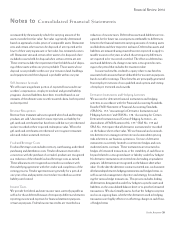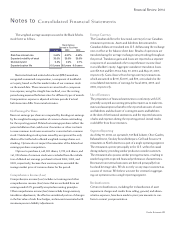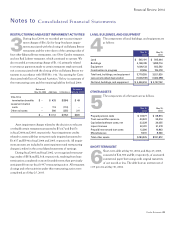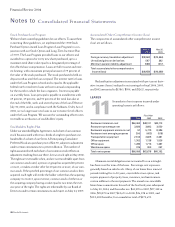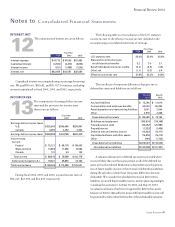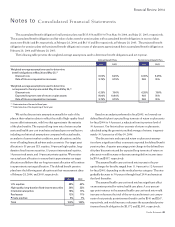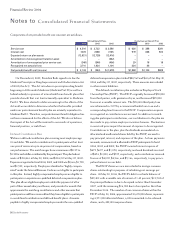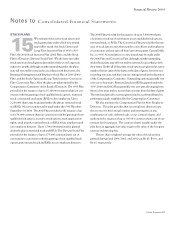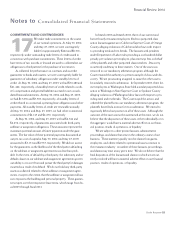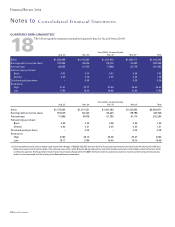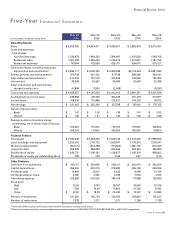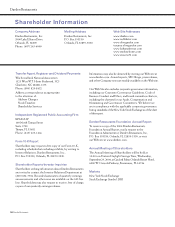Red Lobster 2004 Annual Report Download - page 49
Download and view the complete annual report
Please find page 49 of the 2004 Red Lobster annual report below. You can navigate through the pages in the report by either clicking on the pages listed below, or by using the keyword search tool below to find specific information within the annual report.
Notesto
Consolidated Financial Statements
The accumulated benefit obligation for all pension plans was $135,950 and $119,070 at May 30, 2004, and May 25, 2003, respectively.
The accumulated benefit obligation and fair value of plan assets for pension plans with accumulated benefit obligations in excess of plan
assets were $4,881 and $0, respectively, at February 28, 2004, and $4,515 and $0, respectively, at February 28, 2003. The projected benefit
obligation for pension plans with projected benefit obligations in excess of plan assets approximated their accumulated benefit obligation at
February 28, 2004 and February 28, 2003.
The following table presents the weighted-average assumptions used to determine benefit obligations and net expense:
DefinedBenefitPlans PostretirementBenefitPlan
2004 2003 2004 2003
Weighted-averageassumptionsusedtodetermine
benefitobligationsatMay30andMay25,
(1)
Discountrate 6.00% 6.25% 6.00% 6.25%
Rateoffuturecompensationincreases 3.75% 3.75% N/A N/A
Weighted-averageassumptionsusedtodetermine
netexpenseforfiscalyearsendedMay30andMay25,
(2)
Discountrate 6.25% 7.00% 6.25% 7.00%
Expectedlong-termrateofreturnonplanassets 9.00% 10.40% N/A N/A
Rateoffuturecompensationincreases 3.75% 3.75% N/A N/A
(1)Determinedasoftheendoffiscalyear.
(2)Determinedasofthebeginningoffiscalyear.
49
Financial Review 2004
We set the discount rate assumption annually for each of the
plans at their valuation dates to reflect the yield of high-quality fixed-
income debt instruments, with lives that approximate the maturity
of the plan benefits. The expected long-term rate of return on plan
assets and health care cost trend rates are based upon several factors,
including our historical assumptions compared with actual results,
an analysis of current market conditions, asset allocations, and the
views of leading financial advisers and economists. Our target asset
allocation is 35 percent U.S. equities, 30 percent high-quality, long-
duration fixed-income securities, 15 percent international equities,
10 percent real assets, and 10 percent private equities. We monitor
our actual asset allocation to ensure that it approximates our target
allocation and believe that our long-term asset allocation will continue
to approximate our target allocation. The defined benefit pension
plans have the following asset allocations at their measurement dates
of February 28, 2004, and 2003, respectively:
2004 2003
U.S.equities 38% 42%
High-quality,long-durationfixed-incomesecurities 26% 23%
Internationalequities 18% 17%
Realassets 12% 11%
Privateequities 6% 7%
Total 100% 100%
Based on an analysis performed in fiscal 2003, we lowered our
defined benefit plans’ expected long-term rate of return on plan assets
for fiscal 2004 to 9.0 percent, a reduction from its previous level of
10.4 percent. Our historical ten-year rate of return on plan assets,
calculated using the geometric method average of returns, is approxi-
mately 10.5 percent as of May 30, 2004.
The discount rate and expected return on plan assets assump-
tions have a significant effect on amounts reported for defined benefit
pension plans. A quarter percentage point change in the defined ben-
efit plans’ discount rate and the expected long-term rate of return on
plan assets would increase or decrease earnings before income taxes
by $769 and $357, respectively.
The assumed health care cost trend rate increase in the per-
capita charges for benefits ranged from 11.0 percent to 12.0 percent
for fiscal 2005, depending on the medical service category. The rates
gradually decrease to 5.0 percent through fiscal 2010 and remain at
that level thereafter.
The assumed health care cost trend rate has a significant effect
on amounts reported for retiree health care plans. A one-percent-
age-point variance in the assumed health care cost trend rate would
increase or decrease the total of the service and interest cost compo-
nents of net periodic postretirement benefit cost by $341 and $267,
respectively, and would increase or decrease the accumulated postre-
tirement benefit obligation by $3,572 and $2,805, respectively.


